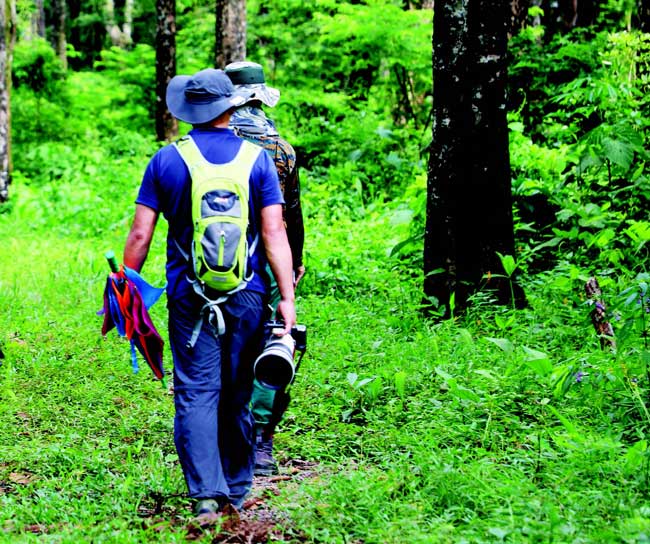The Druk Path Trek follows the ancient trail connecting Paro and Thimphu Valleys and is one of the most popular treks in the country. With easy to moderate difficulty level, the trail runs through scenic wilderness, alpine forest, and lakes, reaching the higher realms of the Himalayas above 4,000m, offering spectacular views of the Himalayan vistas that include Mount Gangkar Phuensum, the highest unclimbed mountain in the world and Mount Jhomolhari.
The best time to trek the Druk Path is from March to June and September to November.The entire trek covers a distance of around 54 kilometers, with relatively short walking distance of 10 kms on average between the camps, providing ample time to take in the scenery. Most people do the trek in four to five days.
A new road now connects Damche Gom, from where it takes only an hour to reach Jela Dzong. So, you have an option to drive till the road point or start hiking a little above Ta Dzong, the national museum. The trail ascends till we reach Jela Dzong, a small monastery perched on the hilltop overlooking Paro and Tsaluna Valley.


The monastery was built in 14th century and served as the residence of Lam Ngawang Chhogyel, cousin of the divine mad monk Lam Drukpa Kuenley. The great Zhabdrung is said to have meditated here before heading down to Paro. From the Dzong, the trail follows long lines of prayer flags and descends through a rhododendron forest and then ascends for another 40-50 minutes. From here, you will get a great view of Paro Valley on a clear day.
The trail then crosses to the east side of the ridge offering views of Bjemina Village in Thimphu. We hike around the west side of the ridge for half an hour, after which we will find yak pasture land at Jangchu Lakha. There are two camping options nearby. If we follow the lower trail, we quickly reach the camping spot at Tshokam (3,770m). The higher trail, which takes around 25 minutes, takes us to the yak herders of Rabana (3,890m).
On the second day, we hike to Jimilang Tsho. Two trails lead to the lake. Most trekkers prefer the higher trail that offers better views including that of Mount Jhomolhari (7,314m) and Mount Jichu Drakey (6,989m). The lower trail descends from Tshokham and then climbs up to the yak pastures of Langrithang.
Following the main trail from Rabana, we ascend the ridge diagonally. We hike for 30 minutes to a meadow and then descend through rhododendron forest to small hills surrounded with prayer flags. After an hour’s walk from the camp, we will come across Langye Ja La (Ox Hump Pass) at 4,070m. From the top of the pass, you will get an impressive 360 degree view of the trekking trails.
From the pass, the descent is quite rocky. After crossing a small herder’s camp, the trail ascends again for around 80 meters to another pass. From here you will get spectacular views of Mount Jhomolhari, Do Chhu Valley and Chumpu Ney, a pilgrimage center famous for its flying statue of Dorje Phamo. A little further, we will see Jimilang Tsho. After a lunch stop, a steep 30-minute descent leads to the shore of Jimilang Tsho, with pleasant camping site at the far end of the lake (3,885m).

Jimilang Tsho (Sand Ox Lake) is located in between two ridges and takes its name from a legend about a bull that emerged from the lake and joined the cattle of a family using the area as a summer grazing ground. The lake is known for its giant trout, which were introduced in the 1970s.
On day three, from the lower end of the lake, we climb through rhododendron forest to a ridge at 4,010m and then descend to a stone shelter. Following the ridge, we come across prayer flags at 4,050m overlooking small Janye Tsho. We descend further to a yak herder’s camp near the lake at 3,880m before climbing again to a ridge at 4,150m, with views
of Simkota Tsho. From Simkota Tsho we continue to ascend through small rhododendron trees until we reach Labana La at 4,235m. The trail then descends gently to cross over another minor pass at 4,210m. From here, we can see Mount Jumolhari and Dochu La. We descend further for around half an hour and reach our camp at Labana. The camp is located just below the main hiking trail.
On day four, we ascend to the main trail and then walk further until the trail starts descending to a final 4,090m pass marked by a chorten with many prayer flags around. The view of entire Thimphu valley is just amazing. We might also get a glimpse of Mount Gangkhar Puensum and other Himalayan peaks in the far distance.
The main trail descends to the northeast but it is worth taking a side trail for around 15 minutes towards Thujidrak Gonpa, a remote meditation center that clings to the side of rock face at 3,950m. Continuing past Thujidrak Gonpa, we will soon reach the meditation houses and lhakhangs of Phajoding Monastery, scattered across the hillside. Phajoding takes its name from the Buddhist saint Phajo Drugom Zhigpo, who meditated here in the 13th century. The monastery itself is an open complex that comprises many holy buildings and relics and a state monastic school that currently houses over 80 monks.



After the monastery, it’s all downhill journey through forest of pine trees. A wide trail passes a chorten at 3,440m and after walking further downhill for 40 minutes we reach a trail junction. The left trail descends via the small historic Chhokhortse Gonpa and drops down to Sangaygang viewpoint. The main route descends more steeply towards Motithang, above the Takin Zoo, from where you can drive to the sprawling Thimphu city for a well deserved rest!



